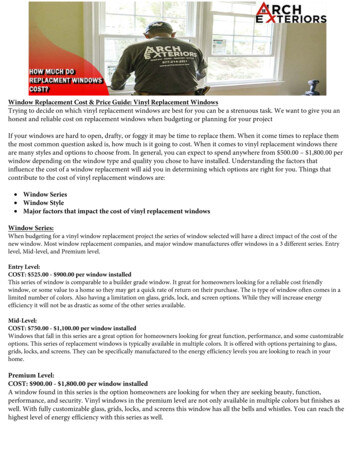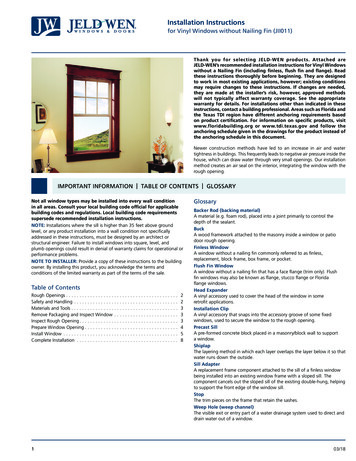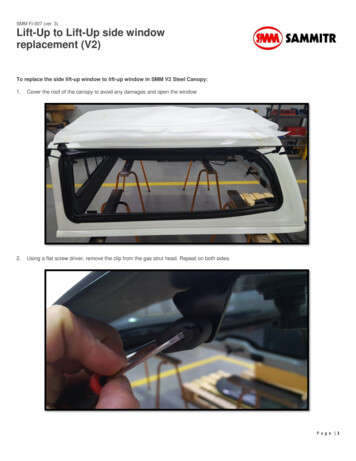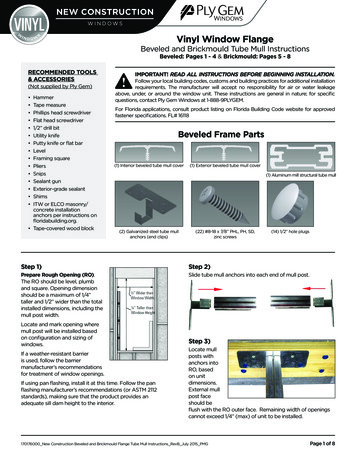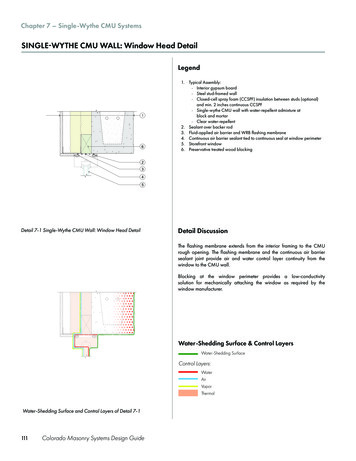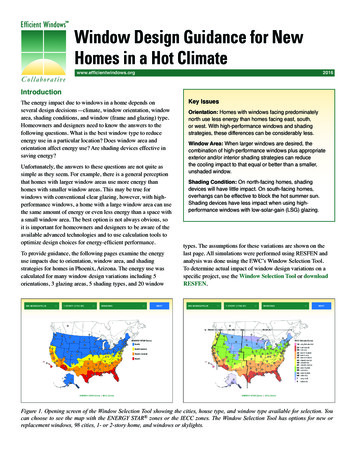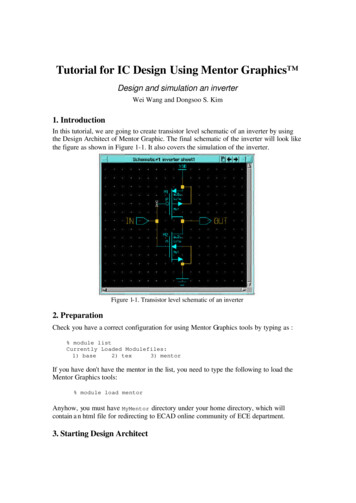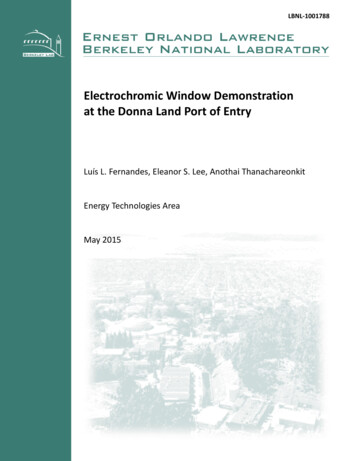
Transcription
LBNL-1001788Electrochromic Window Demonstrationat the Donna Land Port of EntryLuís L. Fernandes, Eleanor S. Lee, Anothai ThanachareonkitEnergy Technologies AreaMay 2015
Prepared for the General Services AdministrationBy Luís L. Fernandes, Eleanor S. Lee and Anothai ThanachareonkitMAY 2015Electrochromic WindowDemonstration at the Donna LandPort of EntryPRINCIPAL INVESTIGATOR: ELEANOR S. LEE
DisclaimerThis document was prepared as an account of work sponsored by the United States Government. While thisdocument is believed to contain correct information, neither the United States Government nor any agencythereof, nor the Regents of the University of California, nor any of their employees, makes any warranty,express or implied, or assumes any legal responsibility for the accuracy, completeness, or usefulness of anyinformation, apparatus, product, or process disclosed, or represents that its use would not infringe privatelyowned rights. Reference herein to any specific commercial product, process, or service by its trade name,trademark, manufacturer, or otherwise, does not necessarily constitute or imply its endorsement,recommendation, or favoring by the United States Government or any agency thereof, or the Regents of theUniversity of California. The views and opinions of authors expressed herein do not necessarily state orreflect those of the United States Government or any agency thereof or the Regents of the University ofCalifornia.The work described in this report was funded by the U.S. General Services Administration and the FederalEnergy Management Program of the U.S. Department of Energy under Contract No. DE-AC02-05CH11231.AcknowledgementsUnited States Customs and Border Protection: Port Director, Assistant Port Directors, supervisors andofficers at the Donna Land Port of Entry.United States General Services Administration: Kevin Powell, Christine Wu, David Gray, Erika Larsen, KevinMyles, Lisa Langham, Jason Williams, Raul Moreno, Cullen Rabel, Bill RuslinkSageGlass: Neil Sbar, Betsy Podbelski, Lou Podbelski, Troy Neirby, Troy Liebl, Josh Battles, Dave BestLawrence Berkeley National Laboratory: Darryl Dickerhoff, Howdy Goudey, Andrew McNeil, Robin Mitchell,David Parker, Alastair RobinsonFor more information contact:Kevin PowellProgram Manager, GSA Green Proving Ground ProgramOffice of the Commissioner, Public Buildings ServiceU.S. General Services Administration50 United Nations PlazaSan Francisco, CA 94102Email: kevin.powell@gsa.govE LE C T RO CH RO MI C WIN D OW DE M ON S TR A TI ON A T THE D ON N A L AN D PO R T O F E N TR Y1
Table of ContentsI.EXECUTIVE SUMMARY3II.INTRODUCTION6A. Problem Statement . 6B. Opportunity . 6III.METHODOLOGY7A. Technology Description . 7B. Technical Objectives . 9C. Demonstration Project Location. 9IV.M&V EVALUATION PLAN13A. Facility Description . 13B. Technology Specification . 18C. Technology Deployment . 22D. Test Plan . 24V.RESULTS28A. Occupant experience . 28B. Daytime visual comfort. 36C. Nighttime visibility . 43D. Glass surface temperature . 47VI.SUMMARY FINDINGS AND CONCLUSIONS49A. Overall Technology Assessment at Demonstration Facility . 49B. Barriers and Enablers to Adoption . 50VII.APPENDICES51A. Surveys . 51B. References . 67E LE C T RO CH RO MI C WIN D OW DE M ON S TR A TI ON A T THE D ON N A L AN D PO R T O F E N TR Y2
I. Executive SummaryThe U.S. General Services Administration (GSA) Public Buildings Service (PBS) has jurisdiction,custody or control over 105 land ports of entry throughout the United States, 35 of which arelocated along the southern border. At these facilities, one of the critical functions of windows is toprovide border control personnel with direct visual contact with the surrounding environment. Thisalso can be done through surveillance cameras, but the high value that U.S. Customs and BorderProtection (CPB) officers place on direct visual contact can be encapsulated in the followingstatement by a senior officer regarding this project: “nothing replaces line of sight.” In sunnyconditions, however, outdoor visibility can be severely compromised by glare, especially when theorb of the sun is in the field of view. This often leads to the deployment of operable shading devices,such as Venetian blinds. While these devices address the glare, they obstruct the view of thesurroundings, negating the visual security benefits of the windows.Electrochromic (EC) windows have the ability to adjust their tint dynamically in response toenvironmental conditions. This provides the potential to control glare by going to a dark tint at timeswhen extreme glare is likely. In previous studies, these windows have shown that this ability tocontrol glare has the potential to increase the amount of time during which view is unobstructed.This technology is available in the U.S. as a commercial product from two vendors with high-capacitymanufacturing facilities, and could be deployed on a nationwide scale if successful in a pilot test.In this project, EC windows were installed at a land port of entry near Donna, Texas. The technicalobjectives of the study were to determine whether the installation of the EC windows resulted inthe following: Reduction in visual discomfort caused by glare from daylight and direct solar orb visibility Reduction or elimination of need for operable shading deployment Improved tenant satisfaction with visibility to the outside No significant negative impact on visibility of the exterior due to the decrease in windowtransmittance.To avoid inordinate installation costs and voiding the warranty of existing bulletproof buildingcomponents, the original windows were kept in place and the EC windows were installed by addinga custom-built, hinged, framed EC window to the existing windows.While EC windows can also provide energy savings, the facility selected for this study is notoptimally suited to demonstrate these benefits. The energy impact of ECs is the focus of othercompleted (Denver Federal Center) and ongoing (Moss Federal Building in Sacramento, California,and the 911 Federal Building in Portland, Oregon) Green Proving Ground (GPG) programdemonstrations.Verification of the attainment of technical objectives was accomplished primarily through surveys ofCBP officers’ perceptions of comfort and visibility through the EC windows. To aid in theunderstanding of survey results, physical measurements were conducted to help quantify daytimevisual and thermal comfort, as well as nighttime visibility through windows.Results from the surveys showed that CBP officers experienced a significant improvement in visualand thermal comfort after EC windows were installed without a significant degradation in daytimeE LE C T RO CH RO MI C WIN D OW DE M ON S TR A TI ON A T THE D ON N A L AN D PO R T O F E N TR Y3
or nighttime visibility. Officers overwhelmingly stated they would prefer switchable EC windows toconventional windows (Table ES-1).Measurements confirmed significant improvements in visual (Figure ES-1) and thermal comfort,although the improvements in thermal comfort were probably largely due to factors other than theEC properties of the windows. They also showed that nighttime visibility might be impaired,especially when interior lights are on, although survey results indicate that CBP officers generally didnot perceive this to be an issue at this facility. During a post-installation site visit, bright reflectionson the interior surface of the EC booth windows were visible (in sunny conditions and with windowsat full tint) when looking into the booth from the outside through the open door. Survey results,however, generally indicated no perceived degradation in daytime visibility.Table ES-1. Responses to two-alternative forced preference between original and EC windows.QuestionOverall, if given the option, would you prefer switchable windowsor conventional windows at the command center/processing area?OptionsNumber of responsesCommand BoothscenterSwitchable windowsConventional, non-switchable windows280240Figure ES-1. Measured Daylight Glare Probability (DGP) in vehicle inspection booths withconventional (gray curve) and EC (blue curve) windows, facing west on the afternoon of October15, 2014, under sunny conditions (i.e., with the sun in the field of view). The booth with ECwindows had much lower DGP throughout the afternoon. Note: DGP is a number between 0 and 1representing the percentage of people that would experience disturbing glare.E LE C T RO CH RO MI C WIN D OW DE M ON S TR A TI ON A T THE D ON N A L AN D PO R T O F E N TR Y4
The results of this study indicate that it is likely that an EC retrofit of this type would have similarperformance if deployed at comparable facilities. This includes other border control facilities, as wellas military, law-enforcement or any other type of governmental or private security facility in which itis valuable to maintain visual contact with the exterior surroundings in glary, sunny conditions.Care should be taken in attempting to extrapolate the results of this study to situations in which theoriginal glazing is replaced by an EC insulated glazing unit (IGU) or if the facility does not have acanopy or deep overhang. In such cases glare control is likely to be less effective due to the highervisible transmittance of the window and the number of hours when the orb of the sun is in the fieldof view. For these situations, the installation of electrochromic windows may not be sufficient tocompletely eliminate the need for view-obstructing interior shading. When replacing the originalglazing with an EC IGU, one possible solution would be to lower the visible transmittance of thebullet-/blast-resistant EC double-pane IGU to the transmittance of the whole assembly studied here(based on the best available information, this transmittance could be as low as 0.21 in the clearstate, and 0.0035 when fully tinted).Care should also be taken when applying any of these configurations (EC IGU add-on to existingwindows or transmittance-matched EC bullet-/blast-resistant IGU) in facilities with particularlystringent requirements for nighttime visibility of dark exterior surroundings. Further testing isrecommended in such situations or, at a bare minimum, an analysis comparing the interior surfacereflectance of the EC IGU (including the original window, in the case of an add-on retrofit like theone studied here) to that of the original IGU.E LE C T RO CH RO MI C WIN D OW DE M ON S TR A TI ON A T THE D ON N A L AN D PO R T O F E N TR Y5
II. IntroductionA. PROBLEM STATEMENTAt land ports of entry, one of the critical functions of windows is to provide border controlpersonnel with direct visual contact with the surrounding environment, allowing them to monitorconstantly the exterior environment for possible suspicious activity. This also can be done throughsurveillance cameras, but U.S. Customs and Border Protection (CPB) officers place very high value ondirect visual contact; this can be encapsulated in the following statement by a senior officerregarding this project: “nothing replaces line of sight.” In sunny conditions, however, outdoorvisibility can be severely compromised by glare, especially when the orb of the sun is in the field ofview. This often leads to the deployment of operable shading devices, such as Venetian blinds.While these shading devices address the glare, they partially or totally obstruct the view of thesurroundings, thereby negating the visual security benefits of the windows.Electrochromic (EC) windows have the ability to adjust their tint dynamically in response toenvironmental conditions. This capability can result in cooling and lighting energy savings [Lee et al.,2006]. It also provides the potential to control glare by going to a dark tint at times when extremeglare is likely. Previous studies have shown that this ability to control glare can significantly increasethe amount of time during which the view is unobstructed by shading devices [Fernandes et al.,2013]. This technology is commercially available in the U.S. from two vendors with high-capacitymanufacturing facilities, and could be deployed on a nationwide scale if successful in a pilot test.B. OPPORTUNITYThis Green Proving Ground (GPG) program study examines whether EC window retrofits can reduceor eliminate the need for view-obstructing blinds in a very specific setting: border crossing stations.While EC windows can also provide energy savings, the facility selected for this study is notoptimally suited to demonstrate these benefits. The energy impact of ECs is the focus of othercompleted (Denver Federal Center [Lee et al., 2014]) and ongoing (Moss Federal Building inSacramento, California, and the 911 Federal Building in Portland, Oregon) GPG programdemonstrations.The U.S. General Services Administration (GSA) Public Building Service (PBS) has jurisdiction, custodyor control over 105 facilities of this type throughout the United States, 35 of which are located alongthe southern border. These facilities approximately range in size from 300,000 rentable ft2 (OtayMesa, CA) to rentable 1,000 ft2 (Poker Creek, AK). These land ports of entry have a combination ofpedestrian, bicycle, private vehicles, commercial trucks, and freight train traffic. The findings of thisstudy also can potentially be relevant to similar facilities oriented towards security and surveillanceoperated by other government, military or private entities.There are potential risks associated with mass deployment of this technology throughout land portsof entry in the United States. Retrofitting EC windows onto these buildings needs to be done whilemaintaining compliance with stringent requirements for bullet or blast resistance and, in someareas, due to frequent hurricanes, wind load resistance. Because of the tint of the EC windows,visibility through windows could be decreased in low outdoor light conditions, especially atnighttime, if indoor light levels and surface brightness are maintained equal.E LE C T RO CH RO MI C WIN D OW DE M ON S TR A TI ON A T THE D ON N A L AN D PO R T O F E N TR Y6
III. MethodologyA. TECHNOLOGY DESCRIPTIONElectrochromic (EC) windows have the ability to change their visible light transmittance dynamically.They achieve this through thin-film coatings applied to glass that can be actively controlled tochange appearance reversibly from a clear to a dark blue tint when a small direct current voltage isapplied by a manual switch or an automated building control system. EC windows preserve theoutward view while modulating transmitted light, glare and solar heat gains.The EC coating itself is a one-micron-thick (1x10-6 m, 4x10-5 in), multi-layer film or stack deposited onglass, usually on the inward-facing surface of the outboard pane of an insulated glazing unit (IGU).Transparent conductors form the outer layers of the stack (Figure 1). Active EC and counterelectrode layers are located adjacent to each of the two transparent conducting layers, facing thecenter of the stack. Finally, an ion-conducting electrolyte layer forms the center portion of the stack.An electric potential is applied to the outer transparent conductors, which causes lithium ions tomigrate across the ion-conducting layer from the counter-electrode layer to the EC layer. Areversible electrochemical reaction takes place causing a tinted Prussian blue appearance. Reversingthe potential causes the ions to migrate back, causing a bleached clear appearance.Figure 1. Component layers of an electrochromic film. Layer thickness not to scale.How fast EC windows transition between states is dependent on temperature and size of thewindow. Transition speed decreases with window size and increases with temperature. Forexample, a 4x5 ft window on a hot day can take 2-3 minutes to switch from clear to fully tinted. A5x8 ft window on a cold day can take 40-60 minutes to switch from clear to its fully tinted state.Most of the transition happens within a relatively short time (e.g., the 5x8 ft window in the exampleabove would only take 5-10 minutes to reach 80% of full tint), with the latter part of the transitiontaking longer.The material and physical composition of the EC window can vary and this dictates the uniqueproperties of the EC window: its switching range, speed versus temperature characteristics, powerconsumption when being switched, durability, and color. EC windows, at this time, areE LE C T RO CH RO MI C WIN D OW DE M ON S TR A TI ON A T THE D ON N A L AN D PO R T O F E N TR Y7
fundamentally the same from the two known U.S. manufacturers that currently offer thistechnology: the EC materials exhibit approximately the same solar-optical properties whenswitched. For both manufacturers, the technology readiness level is in the “late R&D” stage (costreduction and performance improvement stage).As a commercial product, EC windows are deployed as part of a system that includes othercomponents. Light and solar radiation sensors provide information on exterior and interior lightlevels, allowing windows to be controlled accordingly. The automated control system usuallycomprises a central controller, installed in a utility closet, in addition to vendor-specific control andcommunications hardware such as cables and networking hubs. Wall switches allow buildingoccupants to control the tint of the windows manually. The main controller also can be connected toa building automation system (BAS) to be able to respond to specific inputs from the BAS, a controloption that was not implemented in this study because of the focus on visual comfort and visibilityrather than energy performance 1.PREVIOUS CASE STUDIESSeveral monitored demonstrations of EC windows have been undertaken, studying energy andoccupant comfort impacts in conventional office settings to differing degrees. No studies have beenconducted to evaluate performance related to viewing outdoor conditions as the primary tasks. Inthese prior demonstrations, EC windows were either installed anew or replaced the original glass. Afull-scale field test in an office mockup provided rigorous analysis of the window heat gain andlighting impacts of an integrated EC window and lighting system, with occupant satisfactionevaluated over a short period (4-6 hour exposure per subject) [Clear et al., 2006]. Average dailyenergy savings were 10 15% for lighting and 0 3% for cooling [Lee et al., 2006]. A two-yearmonitored installation of EC windows in a large office building demonstrated end user acceptance ofthis technology, but the windows were shaded by a 10-foot deep overhang and conventionalskylights confounded the analysis of energy and occupant impacts [NREL]). An 18-month installationof EC windows and dimmable lighting in a conference room also demonstrated feasibility of thetechnology, but end user acceptance was inferred by manual override switch activity, not directsubjective survey data [Lee et al., 2012]. A prior GPG demonstration at the Denver Federal Centershowed a decrease in glare, although at the expense of perceived daylight levels in the space [Lee etal., 2014]. A recent field study of EC windows in a U.S. Department of Defense office buildingshowed increased occupant satisfaction due to increased access to view [Tinianov, 2014]. Other GPGEC demonstrations are underway in office buildings in Sacramento, California, and Portland, Oregon.Besides visual comfort, EC windows can significantly impact energy consumption in buildings,reducing cooling loads (e.g., the GPG demonstration in Denver predicted a 22% reduction relative toa base case with single-pane clear glass windows [Lee et al., 2014]) and, depending on how they arecontrolled and how shading is used, increasing or decreasing lighting energy consumption. Whilethese are important effects, it would be impractical to include them in this study due to severalfactors specific to the test site - see Section III.C below for more detail.The window control system was actually connected to the BAS, but only for the purpose of logging windowoperation data.1E LE C T RO CH RO MI C WIN D OW DE M ON S TR A TI ON A T THE D ON N A L AN D PO R T O F E N TR Y8
B. TECHNICAL OBJECTIVESThe technical objectives of the study were to determine, from occupant surveys and supportingmeasurements, whether the installation of the EC windows resulted in the following: Reduction in visual discomfort caused by glare from daylight and direct solar orb visibility Reduction or elimination of need for operable interior shading deployment Improved tenant satisfaction with visibility to the outside No significant negative impact on visibility of the exterior due to the decrease in windowtransmittance.Strong evidence for all of these would suggest that ECs are suitable for further deployment in othersimilar land ports of entry or any facilities in which (1) it is important to maintain continuous directvisual contact through windows and (2) severe glare conditions, such as direct visibility of the solardisk, are expected.C. DEMONSTRATION PROJECT LOCATIONThe Donna Land Port of Entry (LPOE) (Figure 2) is a border inspection station located at the borderbetween the United States and Mexico near Donna, Texas, and situated about 50 miles from theGulf of Mexico coast (latitude 26 N, longitude 98 W). The port of entry is in operation on every dayof the year, between 6 AM and 10 PM. The study took place in two areas of the facility: thecommand center and one of the inspection booths for privately-owned vehicular traffic into theUnited States (Figure 3).The command center, located in the secondary inspection building (Figure 4), is the room fromwhich U.S. Customs and Border Protection (CBP) operations in the Donna LPOE are overseen.Command center windows face east, west and south, with vehicular traffic coming from the southpast the inspection booths and into an outdoor inspection area. Inspection booths and the outdoorinspection area are shaded by a large canopy (Figure 5). At nighttime, the inspection area is lightedby luminaires mounted on the underside of the canopy. Horizontal illuminance at night is in the 300400 lx range. The facility grounds, as well as other buildings in the facility, are visible towards thewest and east. In sunny conditions, command center occupants can view the solar disk directlyduring the morning and afternoon, resulting in the need to lower Venetian blinds (Figure 6), therebyblocking the view. During the middle of the day, the sun is blocked by the canopy.The four inspection booths are located to the south of the inspection area and the secondaryinspection building. Booth doors face east. Booths have windows on all four elevations. The southelevation faces the road that accesses the LPOE from Mexico. In sunny conditions, the solar disk isvisible during a substantial part of the day. During normal booth operations, the occupants of theinspection booths spend a substantial amount of time inspecting incoming vehicles. As a result,booth doors are usually open.Due to multiple factors, this facility is not well-suited for the study of energy impacts of EC windows.The heating, ventilating, and air conditioning (HVAC) system is not zoned in a way that allowsseparate monitoring of the areas of the facility under study. These areas represent a small part ofthe facility and impacts on overall HVAC energy use would probably be very hard to discern. Theinspection booths have dedicated HVAC units, but are frequently operated with their doors open inpatterns that are hard to reproduce. During a preliminary visit, it was noted that the commandE LE C T RO CH RO MI C WIN D OW DE M ON S TR A TI ON A T THE D ON N A L AN D PO R T O F E N TR Y9
center was operated with lights turned off, both during the day and at night. In these conditions, itappeared highly unlikely that useful lighting energy impacts would be measureable.Figure 2. Satellite view of the Donna LPOE. U.S.-bound vehicles enter from the bottom. The maininspection area of the port, including the inspection booths and secondary inspection building, arecovered by a canopy. Source: Google Maps.E LE C T RO CH RO MI C WIN D OW DE M ON S TR A TI ON A T THE D ON N A L AN D PO R T O F E N TR Y10
Figure 3. Schematic diagram of the layout of the site, showing approximate relative location ofsecondary inspection building and vehicle inspection booths. Diagram not to scale. Exact shape ofcanopy is not as shown here – see Figure 2; the overhangs project past the dotted line.Figure 4. Secondary inspection building, viewed from the east, with command center to the left.E LE C T RO CH RO MI C WIN D OW DE M ON S TR A TI ON A T THE D ON N A L AN D PO R T O F E N TR Y11
Figure 5. View towards south from outside the command center, with four inspection booths atthe far end of the inspection area. Booth numbering used in this report is also shown.Figure 6. Venetian blinds blocking the view to the west from the command center on a sunnyafternoon, prior to the installation of electrochromic windows.E LE C T RO CH RO MI C WIN D OW DE M ON S TR A TI ON A T THE D ON N A L AN D PO R T O F E N TR Y12
IV. M&V Evaluation PlanA. FACILITY DESCRIPTIONElectrochromic (EC) windows were installed in two areas of the Donna Land Port of Entry: (a)command center and adjacent processing area and (b) vehicle inspection booth no. 3 (see Figure 5for booth numbering). The original windows in the command center are shown in Figure 7. Table 1shows the specifications for the original, dual-pane command center windows. A schematic floorplan of that area is shown in Figure 8. The original vehicle inspection booth windows are shown inFigure 9. Booth windows were single-pane bullet-resistant glass and polycarbonate laminate, 31-mm(1.22-in.) thick 2. The floor plan of a booth is shown in Figure 10. The total area of EC glass installedwas 268 ft2 (236 ft2 in the command center/processing area and 33 ft2 in the vehicle inspectionbooth). The EC windows were installed by adding a custom built frame to the interior (commandcenter/processing area) or exterior (vehicle inspection booth) of the existing windows. Images anddiagrams of the installed EC windows are in Figures 11 to 14.Figure 7. Original windows in the command center.Exact visible transmittance or window composition data were not available for the booth windows. A veryapproximate estimate can be obtained by using the visible transmittance we estimated for the bullet-resistantlaminate of the command center windows. This value is 0.72, but could vary significantly depending on the actuallayer composition of the laminate.2E LE C T RO CH RO MI C WIN D OW DE M ON S TR A TI ON A T THE D ON N A L AN D PO R T O F E N TR Y13
Table 1. Specifications for original windows in command center/processing area.Component/MeasurementSpecificationLayers (outboard to inboard)6 mm gray tinted, heat strengthened glass layer with lowemittance (low-e) coating (pyrolitic) on inward-facing (no.2) surface13 mm air gap36* mm bullet-resistant laminate (3 mm clear w/ low-ecoating (sputtered) on outward-facing (no. 3) surface polycarbonate 3 mm clear with spall resistant film)Visible transmittance 0.35Winter nighttime U-factor 1.65 W/m2-K (0.29 Btu/h-ft2- F)Summer daytime U-factor 1.53 W/m2-K (0.27 Btu/h-ft2- F)Solar Heat Gain Coefficient 0.24Shading coefficient0.28* laminate thickness estimated based on best available informationFigure 8. Floor plan of the command center/processing area.E LE C T RO CH RO MI C WIN D OW DE M ON S TR A TI ON A T THE D ON N A L AN D PO R T O F E N TR Y14
Figure 9. Original windows in vehicle inspection booth no. 4.Figure 10. Floor plan of vehicle inspection booth.E LE C T RO CH RO MI C WIN D OW DE M ON S TR A TI ON A T THE D ON N A L AN D PO R T O F E N TR Y15
Figure 11. EC windows installed in command center. Hinged frame allows the EC window to beopened from the interior for cleaning and maintenance.Figure 12. Floor plan of the command center with interior EC window retrofit.E LE C T RO CH RO MI C WIN D OW DE M ON S TR A TI ON A T THE D ON N A L AN D PO R T O F E N TR Y16
Figure 13. EC windows installed in vehicle inspection booth no. 3.
Electrochromic (EC) windows have the ability to adjust their tint dynamically in response to environmental conditions. This capability can result in cooling and lighting energy savings [Lee et al., 2006]. It also provides the potential to control glare by going to a dark tint at times when extreme glare is likely.



